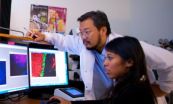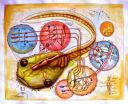(Press-News.org) (Edmonton) In the drive to get small, Robert Wolkow and his lab at the University of Alberta are taking giant steps forward.
The digital age has resulted in a succession of smaller, cleaner and less power-hungry technologies since the days the personal computer fit atop a desk, replacing mainframe models that once filled entire rooms. Desktop PCs have since given way to smaller and smaller laptops, smartphones and devices that most of us carry around in our pockets.
But as Wolkow points out, this technological shrinkage can only go so far when using traditional transistor-based integrated circuits. That's why he and his research team are aiming to build entirely new technologies at the atomic scale.
"Our ultimate goal is to make ultra-low-power electronics because that's what is most demanded by the world right now," said Wolkow, the iCORE Chair in Nanoscale Information and Communications Technology in the Faculty of Science. "We are approaching some fundamental limits that will stop the 30-year-long drive to make things faster, cheaper, better and smaller; this will come to an end soon.
"An entirely new method of computing will be necessary."
Atomic-scale electronics
Wolkow and his team in the U of A's physics department and the National Institute for Nanotechnology are working to engineer atomically precise technologies that have practical, real-world applications. His lab already made its way into the Guinness Book of World Records for inventing the world's sharpest object—a microscope tip just one atom wide at its end.
They made an earlier breakthrough in 2009 when they created the smallest-ever quantum dots—a single atom of silicon measuring less than one nanometre wide—using a technique that will be awarded a U.S. patent later this month.
Quantum dots, Wolkow says, are vessels that confine electrons, much like pockets on a pool table. The dots can be spaced so that electrons can be in two pockets at the same time, allowing them to interact and share electrons—a level of control that makes them ideally suited for computer-like circuitry.
"It could be as important as the transistor," says Wolkow. "It lays the groundwork for a whole new basis of electronics, and in particular, ultra-low-power electronics."
New discoveries pave way for superior nanoelectronics
Wolkow and his team have built upon their earlier successes, modifying scanning tunnelling microscopes with their atom-wide microscope tip, which emits ions instead of light at superior resolution. Like the needle of a record player, the microscopes can trace out the topography of silicon atoms, sensing surface features on the atomic scale.
In a new paper published in Physical Review Letters, post-doctoral fellow Bruno Martins together with Wolkow and other members of the team, observed for the first time how an electrical current flows across the skin of a silicon crystal and also measured electrical resistance as the current moved over a single atomic step.
Wolkow says silicon crystals are mostly smooth except for these atomic staircases—slight imperfections with each step being one atom high. Knowing what causes electrical resistance and being able to record the magnitude of resistance paves the way to design superior nanoelectronic devices, he says.
In another first, this time led by PhD student Marco Taucer, the research team observed how single electrons jump in and out of the quantum dots, and devised a method of monitoring how many electrons fit in the pocket and measuring the dot's charge. In the past, such observations were impossible because the very act of trying to measure something so extraordinarily small changes it, Wolkow says.
"Imagine that if you looked at something with your eyes, the act of looking at it bent it somehow," he says. "We now can avoid that perturbation due to looking, and so can access and usefully deploy the dots in circuitry."
The team's findings, also published in Physical Review Letters, give scientists the ability to monitor the charge of quantum dots. They've also found a way to create quantum dots that function at room temperature, meaning costly cryogenics is not necessary.
"That's exciting because, suddenly, things that were thought of as exotic, far-off ideas are near. We think we can build them."
Taking the next generation of electronics to the market
Wolkow and his team believe so strongly in the commercial potential of atomic-scale circuitry, two years ago they launched their own spinoff company, Quantum Silicon Inc. Over the next five to six years, QSI plans to demonstrate the potential of these "extremely green" circuits that can make use of smaller, longer-lasting batteries.
It also moves them from the realm of basic to applied research and real-world scenarios, Wolkow says.
"We have this nice connection where we have a training ground for students and highly academic ambitions for progress, but those things quite naturally and immediately transfer to this practical entity."
Much of their efforts initially will focus on creating hybrid technologies—adding atom-scale circuitry to conventional electronics such as GPS devices or satellites, like replacing one link in a chain given the time-intensiveness of making the new circuits. It could take a decade before it's possible to mass-produce atom-scale circuitry, but the future potential is very strong, Wolkow says.
"It has the potential to totally change the world's electronic basis. It's a trillion-dollar prospect."
INFORMATION:
The new atomic age: Building smaller, greener electronics
2014-07-07
ELSE PRESS RELEASES FROM THIS DATE:
Study reveals protective role for specialized cells in intestinal and respiratory systems
2014-07-07
RIVERSIDE, Calif. – Ripping a page from the Star Trek script, specialized cells of the barrier that lines the inside of the intestines and airways of humans have invoked a biological version of Captain Kirk's famous command "shields up" as a first defense against invading microbes.
Research in the UCR School of Medicine laboratory of David Lo found that certain cells of the epithelium have a potentially important role in immune surveillance – creating an electrostatic repulsion field to microbial invasion.
The study is featured on the cover of the July issue of Infection ...
Expectant moms turn to 'Dr. Google' for pregnancy advice
2014-07-07
Pregnant women are using the Internet to seek answers to their medical questions more often than they would like, say Penn State researchers.
"We found that first-time moms were upset that their first prenatal visit did not occur until eight weeks into pregnancy," said Jennifer L. Kraschnewski, assistant professor of medicine and public health sciences, Penn State College of Medicine. "These women reported using Google and other search engines because they had a lot of questions at the beginning of pregnancy, before their first doctor's appointment."
Following the women's ...
Summer McJobs are good for kids, says UBC study
2014-07-07
A new UBC Sauder School of Business study shows that teenagers who work at summer or evening jobs gain a competitive advantage later in life. Developing early knowledge of the working world and how to manage in it, they are more likely to find good employment and earn more money in the future.
"With summer in full swing and kids sitting on the couch, parents are wondering whether to push them to find a job," says Sauder professor Marc-David L. Seidel, who co-authored the study. "Parents may think that their kids could do better than a job at the local fast food joint. ...
For a holistic approach to POW trauma
2014-07-07
The full circumstances of U.S. soldier Bowe Bergdahl's captivity have yet to be revealed. During his tour of duty in Afghanistan in 2009, Bergdahl was captured by the Taliban and held in captivity for five years until a controversial prisoner exchange led to his release on May 31. Bergdahl has been accused of deserting his post and advocating the release of Afghani prisoners.
"We do know that he suffered horrific conditions, tortured and kept in a metal cage in darkness for weeks on end," said Prof. Zahava Solomon, an Israel Prize laureate, Professor of Social Work and ...
Patient patience and pandemics
2014-07-07
Allowing patients to choose which hospital they attend when suffering illness during a pandemic rather than assigning them to a specific healthcare facility is appealing to patients during such a crisis. However, such a patient-centric hospital capacity management is conventionally viewed as inefficient system-wide. According to research published in the International Journal of Mathematics in Operational Research, an incentive-based approach for hospital capacity management can not only accomplish a high efficiency for a concerned hospital system but satisfy patients' ...
World Cup chemistry: The science behind the 'brazuca' (video)
2014-07-07
WASHINGTON, July 7, 2014 — The World Cup final is almost here, and no matter which two teams meet for the title match, there's one thing they'll both need to win: the ball. This week, Reactions examines the chemistry that goes into making the "brazuca," and what makes it different from most other soccer balls out there. The video is available at https://www.youtube.com/watch?v=1XNTfslUzt8.
INFORMATION:
Subscribe to the series at Reactions YouTube, and follow us on Twitter @ACSreactions to be the first to see our latest videos.
The American Chemical Society is a nonprofit ...
Infant toenails reveal in utero exposure to low-level arsenic, Dartmouth study finds
2014-07-07
Infant toenails are a reliable way to estimate arsenic exposure before birth, a Dartmouth College study shows.
The findings appear in the Journal of Exposure Science & Environmental Epidemiology. A PDF of the study is available on request.
A growing body of evidence suggests that in utero and early-life exposure to arsenic may have detrimental effects on children, even at the low to moderate levels common in the United States and elsewhere. The fetus starts to develop toenails during the first trimester, making them an accurate measure of exposure to arsenic during ...
GVSU researchers find moral beliefs barrier to HPV vaccine
2014-07-07
GRAND RAPIDS, Mich. — A survey of first-year Grand Valley State University students showed the biggest barrier to receiving a Human Papillomavirus (HPV) vaccine was moral or religious beliefs, or a perceived promotion of sexual behavior, according to graduate physician assistant researchers.
Physician Assistant Studies majors Jamie Phillipich and Margie Webb surveyed 1,000 incoming students last fall as part of their master's research project. They assessed the influence media has on the perception of HPV and vaccine compliance, and presented their findings at the Annual ...
Dodging dots helps explain brain circuitry
2014-07-07
PROVIDENCE, R.I. [Brown University] — A neuroscience study provides new insight into the primal brain circuits involved in collision avoidance, and perhaps a more general model of how neurons can participate in networks to process information and act on it.
In the study, Brown University neuroscientists tracked the cell-by-cell progress of neural signals from the eyes through the brains of tadpoles as they saw and reacted to stimuli including an apparently approaching black circle. In so doing, the researchers were able to gain a novel understanding of how individual ...
Satellites reveal possible catastrophic flooding months in advance, UCI finds
2014-07-07
Irvine, Calif., July 7, 2014 – Data from NASA satellites can greatly improve predictions of how likely a river basin is to overflow months before it does, according to new findings by UC Irvine. The use of such data, which capture a much fuller picture of how water is accumulating, could result in earlier flood warnings, potentially saving lives and property.
The research was published online Sunday in the journal Nature Geoscience.
A case study of the catastrophic 2011 Missouri River floods showed that factoring into hydrologic models the total water storage information ...



